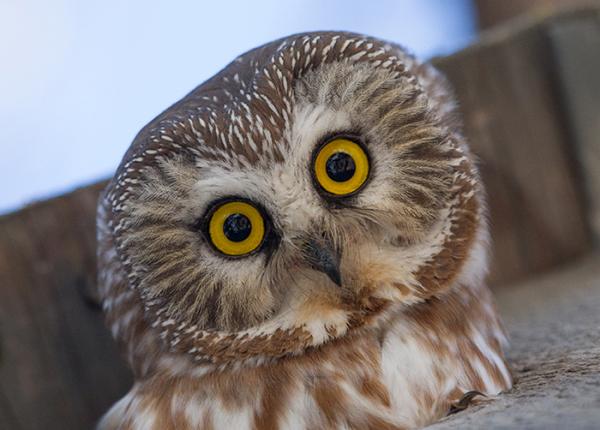From New Mexico Wildlife Center
There’s a cool secret hidden behind the flat facial disc of a Northern Saw-whet Owl: absolutely enormous ears!
While Northern Saw-whet Owl 24-988 was sedated for a bandage change recently, we parted the feathers at the edge of her facial disc to show one of her ear openings.
This species has asymmetrical ears - one placed higher than the other - which gives them the ability to hear in three dimensions! We humans, with our symmetrical ears, can judge pretty well how near or far a sound is and whether it’s coming from our left or our right, but it’s difficult for us to tell whether a sound is coming from up high or down on the ground.
That’s not a problem at all for a Northern Saw-whet Owl, since they can notice in an instant when a sound coming from down low reaches their lower ear a fraction of a second before it’s detected by their higher ear.
Those ear openings are so large that it’s possible to see the back of an owl’s eye through the ear hole. See that darker, bluish-grey structure in the ear? That’s the back of 24-988’s right eye!
Owls’ eyes are also enormous - each one about as big as their entire brain - which allows them to see very well in the dark, but it also means that when an owl sustains a head injury, there’s also a high likelihood of injury to one or both eyes.
When we do an intake exam on an owl, we often look into the ears to check for bruising on the back of the eyes. In 24-988’s case, she did have a minor injury to her right eye, which healed quickly with medication.
Her ears and eyes look great, and her fractured femur and scapula are also nearly healed!

Eye ball reachable from the back side. That must be every ophthalmologist’s dream!
Asymmetric ears. Nice. :)
Nothing is for free in this world! Owl eyes come with some tradeoffs. Their eyes are not spherical as ours are. They are bulb shaped, and as a result they cannot move in their head, they are fixed in place. This is one of the reasons for the owls’ head contortions. As it can’t move its eyes, it has to move the whole head to look around.
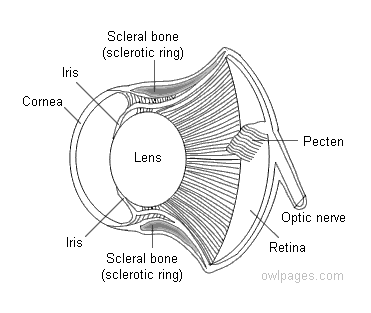
This also leaves them with a considerable blind spot at their beak. To overcome this, as they need to shove food in there with their foot, the owl’s moustache, properly known as rictal bristles, are sensory, to help them “see” what is in front of their face.

Next, owls are around 50% feathers by volume, and the rest is head, massive pectoral muscles, and legs held together by a minimum of other stuff to save weight. That leaves the head as one of the largest parts of their body. When flying around face first, that ends up being their crumple zone in a collision. Those delicate eyes are very prone to injury. Almost any owl crash is going to result in a concussion and eye damage. I got some photos of that damage last night after hearing so much about it. I’m debating sharing them, because while I find it very educational, it isn’t the most pleasant topic.
Here is a diagram of the eye sockets and asymmetrical ear openings. I think the majority of owls do have asymmetrical ears, but definitely not all. The Fish Owls are one group that I’m pretty sure does not, because it’s not as though they can hear fish under the water. I don’t really have a way I think is adequate to explain the extra dimensional hearing other than they just have one more (though 50% more to be fair) data point than we have with level ears. Some sounds we are left to sort out monaurally, while the owls have a minimum of 2 dimensions to analyze, and optimally 3 instead of 2. They’re just always working with more data.
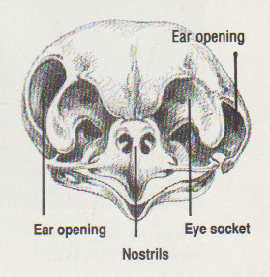
It doesn’t end there though! The facial disc itself is parabolic, directing sound straight into those massive ear canals. The ring around the disc is made of stiff feathers to direct any available sound into that parabolic structure. They also have muscle control over the facial feathers, letting them tune the frequency they are focusing on. Add in the head tilts, and that lets them really dial in the location of what they are listening for.
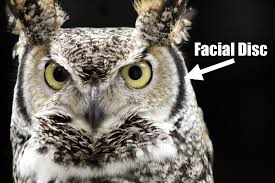
These are just the beginning of some of the special powers many owls possess, but you can see there are caveats to them. It’s still really darn cool, and I wouldn’t mind trying out their hearing or vision!
So they hear with their face (-ial disc) and see with their beard/ whiskers. Understood. :)
Thank you for the well done explanation.
You got it!
Certainly! I want everyone to know an owl is more than just a pretty face. They are very OP in a ton of cool ways.
The Fish Owls are one group that I’m pretty sure does not, because it’s not as though they can hear fish under the water.
I wouldn’t be surprised if they can actually hear the fish, especially if they’re hunting in shallow water like this. It seems like not too much is known about fish owls, but owls in general have a similar hearing range as us (200 to 12,000 Hz for them, 20 to 20,000 Hz for us). So if people can hear the fish moving around, it would seem like the owls could too. And they’re better at picking up quiet sounds. (Article is long, ctrl+F “faint”.)
I would definitely be curious to try an owl’s hearing on for size. I don’t have trouble telling if sounds are coming from high or low, but I would bet their ears can do it better, or different. But it’s pretty amazing what even human ears can do. Like this story about how native people in Brazil can “hear the fish singing.” Sounds kind of crazy, maybe, but sometimes you just have to listen closely to hear things.
The article with the fish songs was very interesting! I found a brief video of a lady studying fish voices that gave some examples.
I’ve read a good bit of the other article’s study by Payne and Friends and did my version of an ELI5 about it here before. The Payne family comes up every time bioacoustics is brought up, and I really need to get to some of their books at some point. The first portion of the article was fun, as it seemed a bit more simplified than the research papers, but then it got into the same more expert language and I got lost on anything deeper than what I’d already translated for myself previously.
If you can appreciate the details of that one more than I can, when looking for a list of owls with symmetrical vs asymmetrical ears, I found this paper testing frequency response and what sounds they hear best if you want to take a look at that.
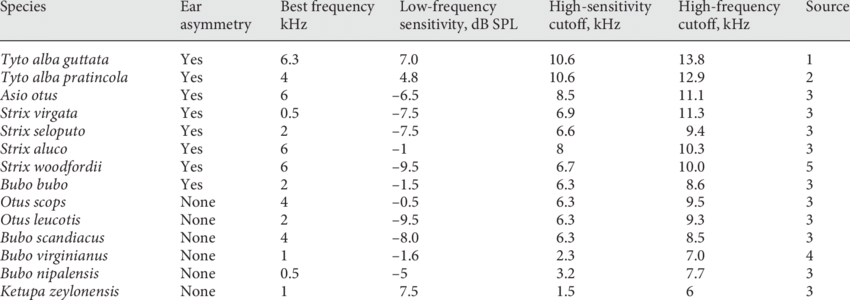
This chart from this paper lists the Brown Fish Owl as symmetrical, along with the GHO and Screech among others, and the Burrowing and Little Owls are also symmetrical. There looks to be a lot of owls listed as asymmetrical that aren’t when reading less technical sources, so it was a bit tricky to find something that seemed completely reliable.
Thanks for the reads! Things like this really remind us how much about our own world we still don’t know and have to look forward to discovering!
I read the first and last couple pages of the article. It starts to make my head hurt at some point, but I get the gist. I thought it was interesting that the feathers over their ears are designed to let sound through. And owls with asymmetrical ears tend to be better at hearing higher frequencies. Which seems to be because they have more space in their inner ear, and more tiny hairs that can amplify or transmit the sound.
The fish sounds were interesting too. It sounds kind of like the deeper sounds might be coming from the swim bladder. Off topic but fun fact: the swim bladder can change during the breeding season so it’s easier to make mating calls for hours on end.
Lol horny fish.
It seems they still didn’t have much of an idea why some owls have the extra internal skin flap in the ear canal. I love they’re still keeping so many secrets from us!
I figured the flaps would be to keep dust and things out of their ears, but apparently they can be moved to help focus or filter sound. Source 1 (easier to read). Source 2 (more technical). Ctrl+F “flap” in both articles.
I saw a couple places that said closing the flaps can block out noise while the owls sleep.
It would make sense if you had super hearing that there would be situations where you may want to have a damper for that power. My head hurts too much from not feeling good to read the articles yet, but I did skim them a bit and there’s some really good flap pics in there! Thanks for sharing them. You’ve been bringing a lot of great stuff to me this week and I appreciate it!
24-988 was my number,
Was my number now,
Right now, somebody else, has that number
One more time!
We’ve got some real music connoisseurs here at times! You expose me to such diverse things.

